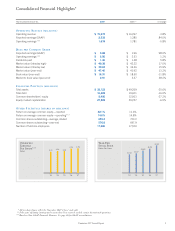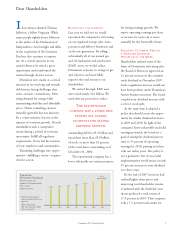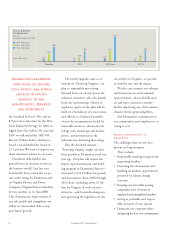Dominion Power 2007 Annual Report Download - page 9
Download and view the complete annual report
Please find page 9 of the 2007 Dominion Power annual report below. You can navigate through the pages in the report by either clicking on the pages listed below, or by using the keyword search tool below to find specific information within the annual report.
Dominion 2007 Annual Report 7
Responsibly Meeting
Energy Needs in Growing
Markets
Consider the superb location of our
existing businesses, and you will see
our growth opportunities.
Dominion is extremely fortunate
to provide vital energy and energy
services in strong markets in the
mid-Atlantic, Midwest and
Northeast. Each market has a need
for more energy and expanded energy
infrastructure. And each operates
under starkly different rules.
We serve regulated electric
markets in fast-growing Virginia and
regulated retail natural gas markets
in Ohio, Pennsylvania and West
Virginia. We also supply retail
customers in selected local markets
that successfully developed retail
competition.
In addition to the electric generat-
ing facilities dedicated to serving our
utility customers, we own and operate
a well-positioned “merchant” fleet that
has access to deregulated wholesale
markets in New England and the
Midwest. Equally well positioned is
our expanding base of natural gas
transmission and storage facilities
providing services to the largest gas-
consuming markets in the country.
The portion of the E&P business
that we kept—about 1.1 trillion
cubic feet equivalent of proved natu-
ral gas and oil reserves—resides in
the Appalachian Basin, where the gas
feeds into our pipeline and storage
system from a near-perfect location.
The geology of the region also lends
itself to low-cost, low-risk drilling
and long-lived production.
Explaining the foundation of our
expected growth—and how our
shareholders and customers profit
from that growth—has a logical
starting point in Virginia, among the
fastest growing of the many strong
markets that we serve. About two-
thirds of our electric generation
serves our electric utility customer
base of nearly 2.4 million homes and
businesses in Virginia and northeast-
ern North Carolina.
RISING DEMAND IN VIRGINIA
Over the next decade the demand
for electric generation in Virginia is
projected to grow by approximately
4,000 megawatts—enough to
provide power for 1 million homes.
Growing demand already strains
the electric grid, with usage expand-
ing faster than expected.
Moreover, Virginia relies on import-
ed power from other states to help meet
current demand, making it the nation’s
second largest net importer of electric
power, behind only California. We can-
not, however, continue to rely on these
imports. While demand grows in
other regions, little new low-cost gen-
eration is scheduled to come on line.
How can we meet Virginia’s rising
demand?
COST-EFFECTIVE ENERGY
CONSERVATION AND
LOAD MANAGEMENT EFFORTS
First, Dominion continues to expand
its cost-effective energy conservation
and efficiency efforts. Our attempts
to encourage wise energy use began
long ago, but we have substantially
stepped up the pace.
In the fall of 2007 we launched
a program to provide discounts
on energy-saving compact fluorescent
light bulbs (CFLs). It was a hit.
Customers snatched up nearly
600,000 bulbs in about three months
and we have raised our target to
5 million CFLs by the end of 2009.
Achieving this target would result in
a conservation-driven carbon
reduction equivalent to the removal
of almost 270,000 cars from the
road for one year.
This year, to keep expanding the
effort, we plan to initiate nine
energy conservation pilot programs.
NEW GENERATION ISNECESSARY
Conservation and load management
will reduce the rate of demand
growth, but they cannot eliminate it.
Investing in new generation capacity
is imperative.
OUR ATTEMPTS TO ENCOUR-
AGE WISE ENERGY USE BEGAN
LONG AGO, BUT WE HAVE
SUBSTANTIALLY STEPPED UP
THE PACE.






















